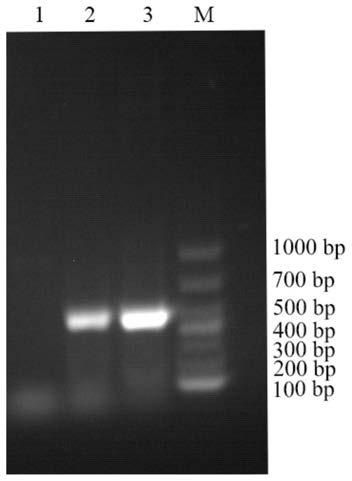ELISA detection method for canine distemper virus and antibody
A technology for canine distemper virus and canine distemper, applied in the direction of virus/bacteriophage, virus, virus peptide, etc., to achieve good antigenic effect
- Summary
- Abstract
- Description
- Claims
- Application Information
AI Technical Summary
Problems solved by technology
Method used
Image
Examples
Embodiment 1
[0075] Example 1 Obtaining of pET-22b-N vector
[0076] 1. Experimental method
[0077] 1. Use vero cells to culture the CDV-1 virus strain, freeze and thaw it three times, and collect the virus. Use the small amount of RNA extraction kit to extract the virus RNA, and use the RNA inversion kit to reverse the extracted RNA into cDNA, and save it. to 4°C refrigerator.
[0078] 2. According to the CDVgp1nucleocapsid protein N gene sequence (Gene ID: 1489798) registered in GenBank, using the inverted cDNA (nucleotide sequence shown in SEQ IN NO: 1) as a template, design a pair of primers N-F / N-R ( Table 1), amplify the N coding region, introduce SalI and NotI restriction sites and His tag sequence, and obtain the N target fragment.
[0079] 3. Connect the N fragment and the pMD18-T vector by TA cloning, and then carry out transformation screening to obtain the recombinant plasmid pMD-N; the recombinant plasmids pMD-N and pET-22b are respectively treated with restriction enzymes ...
Embodiment 2
[0088] Example 2 Obtaining of CDV N protein
[0089] 1. Experimental method
[0090] 1. Transfer pET-22b-N from Example 1 or into E.coli DH5α competent, and after being identified as positive, extract the plasmid after massive expression in Amp-resistant LB.
[0091] 2. Transform the extracted pET-22b-N into Rosetta (DE3) competent bacteria, amplify the target bacterial strain, obtain the target plasmid pET-22b-N through the plasmid extraction kit, and transform it into the expression strain Rosetta (DE3 ) competence, plate screening to obtain a single clone of the target strain.
[0092] 3. Pick a single colony identified as positive and culture it to OD 600 When = 0.8 ~ 1, add IPTG to the medium to make the final concentration 1mmol / L, continue to cultivate for 6 hours, and collect the precipitate by centrifugation at 12000r / min for 15 minutes.
[0093] 4. Resuspend the bacterial cells induced in the previous step in PBS for sonication, and centrifuge at 12,000 r / min at 4...
Embodiment 3
[0114] Example 3 CDV N protein immunized mice
[0115] 1. Experimental method
[0116] 1. Use the BCA protein quantification method to determine the concentration of the expression product in Example 2, dilute the obtained protein with PBS to 100 μg / 0.1mL, and mix it with Freund’s complete adjuvant in equal volume; use the piston tube method to emulsify the target protein to make the protein Form a "water-in-oil" state. The judgment method is to drop the emulsified protein into a plate filled with water. If the target protein does not spread within 10 minutes, it means that the emulsification is successful; Inject 300 μg / mouse at multiple points on the back of the mouse, and inject 0.2 g / mL 200-400 mL of veterinary penicillin sodium into the leg muscles of the mice. The specific injection volume depends on the weight of the mice.
[0117] 2. The second immunization was carried out on the 14th day after the first step of immunizing the mice to strengthen the immune effect. Th...
PUM
 Login to View More
Login to View More Abstract
Description
Claims
Application Information
 Login to View More
Login to View More - R&D Engineer
- R&D Manager
- IP Professional
- Industry Leading Data Capabilities
- Powerful AI technology
- Patent DNA Extraction
Browse by: Latest US Patents, China's latest patents, Technical Efficacy Thesaurus, Application Domain, Technology Topic, Popular Technical Reports.
© 2024 PatSnap. All rights reserved.Legal|Privacy policy|Modern Slavery Act Transparency Statement|Sitemap|About US| Contact US: help@patsnap.com










